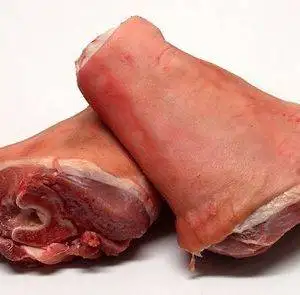Description
Frozen Pork Ear: Nutrition, Recipes, Benefits, and Complete Guide
Introduction
Frozen pork ear is more than just a by-product of butchering. Rich in protein, collagen, and flavor, it has been cherished in global cuisines for centuries. Today, it’s gaining renewed attention not only in kitchens but also as a natural chew treat for dogs.
This guide will walk you through the nutritional profile of frozen pork ear, its cultural significance, popular recipes, benefits for pets, safety tips, and storage guidelines.
Nutritional Profile of Pork Ear
Frozen pork ear is nutrient-dense and collagen-rich, making it beneficial for both humans and pets.
Nutritional highlights (per 100g serving):
-
Protein: 20–25g
-
Collagen & Gelatin: Supports skin and joint health
-
Fat: 10–15g
-
Vitamins & Minerals: B-vitamins, iron, zinc
Frozen Pork Ear in Human Cuisine
Global Culinary Traditions
-
China: Served in cold garlic-chili salads.
-
Philippines: Featured in the sizzling dish sisig.
-
Spain: Popular as crispy tapas (oreja a la plancha).
-
Brazil: Included in the black bean stew feijoada.
-
Eastern Europe: Pickled or used in soups and aspic.
Flavor & Texture
Tender yet chewy with a gelatinous bite, absorbs marinades well, making it versatile in different dishes.
How to Prepare Frozen Pork Ear
Thawing
-
Refrigerator (12–24 hours) – safest method.
-
Cold water bath – quicker but requires frequent water changes.
-
Avoid microwaves to prevent uneven thawing.
Cleaning & Pre-Cooking
-
Rinse thoroughly.
-
Blanch in boiling water for 5–10 minutes to remove impurities.
Storage Tips
-
Keep below –18°C (0°F).
-
Shelf life: 6–9 months frozen.
-
Once thawed, cook within 24 hours.
Popular Recipes Frozen Pork Ear
1. Braised
Cook slowly with soy sauce, garlic, ginger, and spices for a tender, savory dish.
2. Crispy Fried
Boil, slice, then deep-fry until golden and crunchy. Serve with vinegar or chili dip.
3. Asian-Style Pork Ear Salad
Thinly slice, chill, and toss with sesame oil, soy sauce, garlic, chili, and herbs.
4. Pork Ear Tacos
Grill or fry, then wrap in tortillas with salsa, lime, and cilantro.
Frozen Pork Ear for Pets
is also a popular treat for dogs.
Benefits for Dogs
-
High in protein and collagen.
-
Supports dental health by reducing tartar.
-
Provides mental stimulation and chewing enrichment.
Frozen vs. Dried Pork Ear
-
Frozen: Moist, less processed.
-
Dried: Crunchy, longer shelf life.
Safety Tips
-
Always supervise your dog.
-
Feed in moderation (high fat content).
-
Avoid if your pet has dietary restrictions.
Health Benefits for Humans
Eating pork ear offers:
-
Collagen boost – promotes skin elasticity and joint health.
-
Protein intake – supports tissue repair and muscle strength.
-
Sustainable eating – promotes nose-to-tail cooking.
Risks & Precautions
-
High in fat: Not ideal for low-fat diets.
-
Food safety risks: Must be cooked thoroughly.
-
Dietary restrictions: Unsuitable for vegetarians and those avoiding pork.
Buying & Storing
Where to Buy
-
Asian supermarkets
-
Local butchers
-
Online specialty meat suppliers
Choosing Quality
-
Look for pale pink color.
-
Avoid freezer-burnt pieces.
-
Prefer vacuum-sealed packaging.
Sustainability & Ethical Aspects
Frozen pork ear plays a role in sustainable cooking by:
-
Reducing food waste (nose-to-tail eating).
-
Providing affordable nutrition.
-
Supporting ethical consumption practices.
Conclusion
is a surprisingly versatile ingredient that combines tradition, nutrition, and sustainability. From Asian salads and Spanish tapas to dog chews, it proves that no part of the animal should go to waste.
Whether you’re exploring new recipes, seeking collagen-rich nutrition, or looking for a natural dog treat, https://en.wikipedia.org/wiki/Meat_chopfrozen pork ear is an ingredient worth adding to your shopping list.







Reviews
There are no reviews yet.